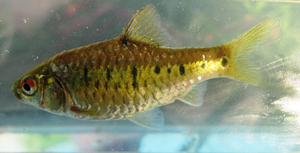Brass barb
| Brass barb | ||||||||||||
|---|---|---|---|---|---|---|---|---|---|---|---|---|

Brass barbel ( Barbodes semifasciolatus ) |
||||||||||||
| Systematics | ||||||||||||
|
||||||||||||
| Scientific name | ||||||||||||
| Barbodes semifasciolatus | ||||||||||||
| Günther , 1868 |
The brass barbel ( Barbodes semifasciolatus , syn .: Puntius semifasciolatus ), as a xanthic (yellowish) cultivated form also called brocade barbel , is a carp fish (Cyprinidae) very popular with aquarists as a beginner ornamental fish .
features
Brass and brocade barbs are about 7 to 10 cm long, with the males being slightly smaller, slimmer and more colorful. According to their name, the brass barbs are shiny brass-colored . In the brocade barb, the red belly color of the brass barb can still be seen. They reach an age of around six years.
Occurrence
Brass barbs are found in northern Vietnam and southeastern China , including Hainan . They are rarely seen on the surface of the water, they prefer the lower water areas.
As a cultivated form of the brass barbel, brocade barbs do not occur in the wild.
Aquaristics
Water values
Brass and brocade barbs should be kept in a relatively large, closed aquarium (from 150 l and at least 100 cm in length), given the water values
- pH value : 6 - 8
- Total hardness : up to 20 ° dH,
- Carbonate hardness: up to 15 ° dH,
- Water temperature: 18 - 24 ° C.
attitude
Brass and brocade barbs are very lively and curious, they are mostly in the lower and middle pelvic area. A sandy or silted soil with dense vegetation is best suited , with algae growth the body color becomes more intense. Since they are schooling fish, at least eight to ten individuals should be kept together. In tanks that are too small and if kept alone, they quickly become shy and usually hide behind plants. They can be with all the fried fish that prefer colder water temperatures also, socialize, for example with superb barbel ( pethia conchonius ) and Ritterkärpflingen ( Xenoophorus captivating ). If, on the other hand, the population density in the aquarium becomes too high, they become aggressive towards other species.
nutrition
Brass barbs have an omnivorous diet, but prefer plant-based foods.
breed
For breeding purposes, a well-fed couple is placed in a breeding tank in the evening. The female spawns mostly in the morning on Java moss ( Vesicularia dubyana ab), as they are but spawning robbers who Altfische then from the breeding tank should be removed. The spawn should be protected with fine gravel or spawning grate until they hatch in 30 to 36 hours . After two to three days the fry are swimming around freely. They can be relatively easy to start with microworms and newly hatched Artemia - nauplii and later wind up with dry food. In a densely overgrown aquarium, some young animals can survive even if the old fish have not been removed.
Web links
- Brass barbel on Fishbase.org (English)
- www.zierfischverzeichnis.de - Brokatbarbe / Messingbarbe - Description, photos and distribution map
- Barbodes semifasciolatus inthe IUCN 2013 Red List of Threatened Species . Posted by: The Anh, B., 2011. Retrieved December 17, 2013.

